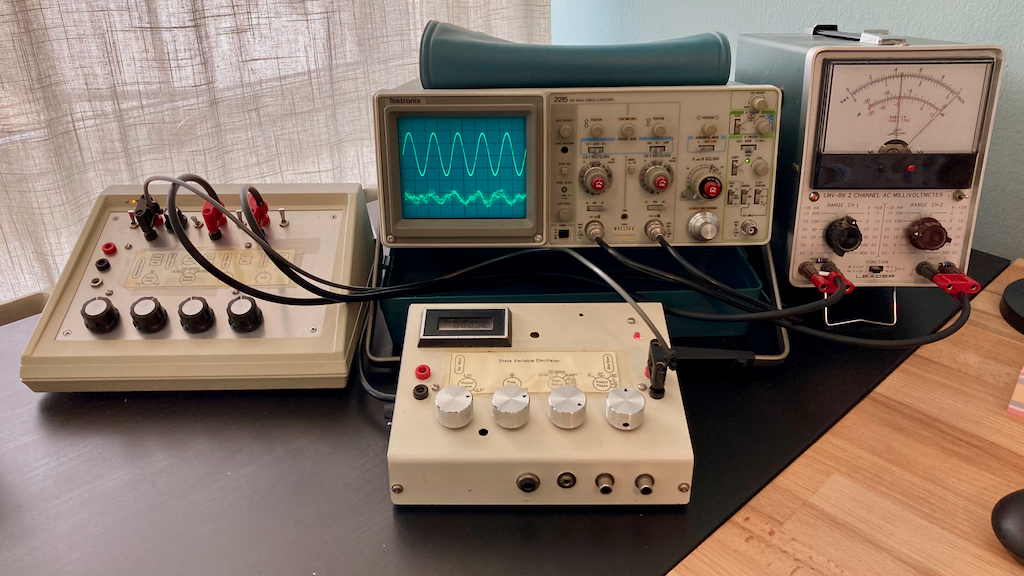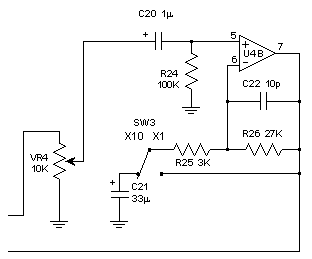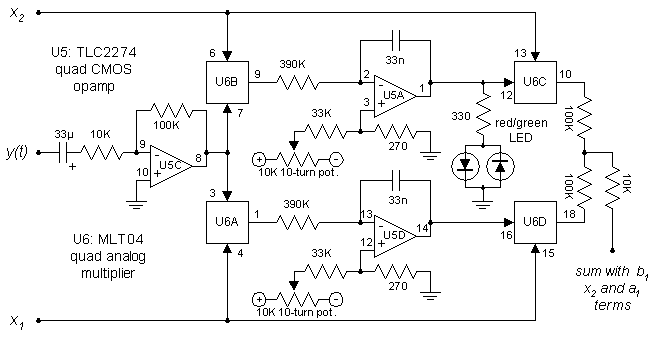

My article on "Notch Filter Design" in the ONE:2000 issue of Audio Electronics magazine shows how to use a desktop computer to solve the complex arithmetic needed to design state-variable filters for audio use. Construction of a tunable notch filter for measuring harmonic distortion is featured.
Audio Amateur Corp. did a beautiful job (as always) of editing and presenting my article. For those of you who are planning to build my notch filter however, several typos snuck in which should be clarified.
In the schematic diagrams, I didn't show the power supply connections to the opamps, but probably should have. Connect +15 Vdc (filtered, regulated, and bypassed) to pin 8 of each LF353. Connect -15 Vdc (filtered, regulated, and bypassed) to pin 4 of each LF353.
On page 14 under the heading "Constructing the Prototype" I make a statement regarding the input preamp U4B that "distortion was higher when I configured the preamp for unity gain." The increase in distortion is actually due to a design error on my part which is easily corrected. It turns out that JFET input opamps have a unique distortion mechanism that only comes into play when used in a non-inverting circuit, as is U4B in Figure 5. Input capacitance varies with common mode voltage, making the inputs non-linear at high frequencies when the source impedance is high. This is the case for the inverting input of U4B when unity gain is selected. The solution is to configure SW3 so that R26 is shunted by a much smaller parallel resistance when unity gain is selected. The following circuit diagram shows the correction:

I learned about this issue from a Burr-Brown data sheet, available online at: OPA 134 Audio Operational Amplifier. I also changed the values of R25, R26, and C21 so that the amplifier gain is now exactly 'times 10'.
I've already finished one of the enhancements I mentioned on page 17 under the heading "Further Development". I've used the MLT04 quad analog multiplier from Analog Devices to implement an auto-tune and auto-null add-on circuit. This makes the notch filter much easier to use, especially when measuring distortion levels of 0.1% or less. Here is the complete schematic:

Note that this circuit can be used without modifying the original notch filter circuit. On my original prototype, I just added a jumper with connections for power, ground, x2, y(t), x1, and an input to the summation of b1, x2, and a1. I did however have to replace the power supply with a +/- 5 Vdc unit, since both the TLC2274 and the MLT04 must be used with +/- 5 Vdc supplies. This had little effect on notch filter performance, but does limit headroom quite a bit.
I follow the design of C. Lau [1980] pretty closely, although I used multipliers at U6A and U6B instead of choppers for synchronous detection. I've also added a bi-color LED to indicate if coarse tuning should be adjusted up or down. The front panel fine tune and null adjustments don't affect operation of the automatic circuit, and can be left centered. The 10-turn potentiometers are used to account for offset voltages in the multipliers and op-amps. With a 1 Vrms input having very low distortion, adjust the trim pots iteratively until notch filter output is minimized. Jog the front panel fine tune and null adjustments to watch the automatic adjustments take over. The auto tune and auto null circuits operate independently, and can be inhibited by shorting across either or both of the 33nF integrating capacitors.
At the end of the article, I gave several references that include web links which are typed below for your convenience:

